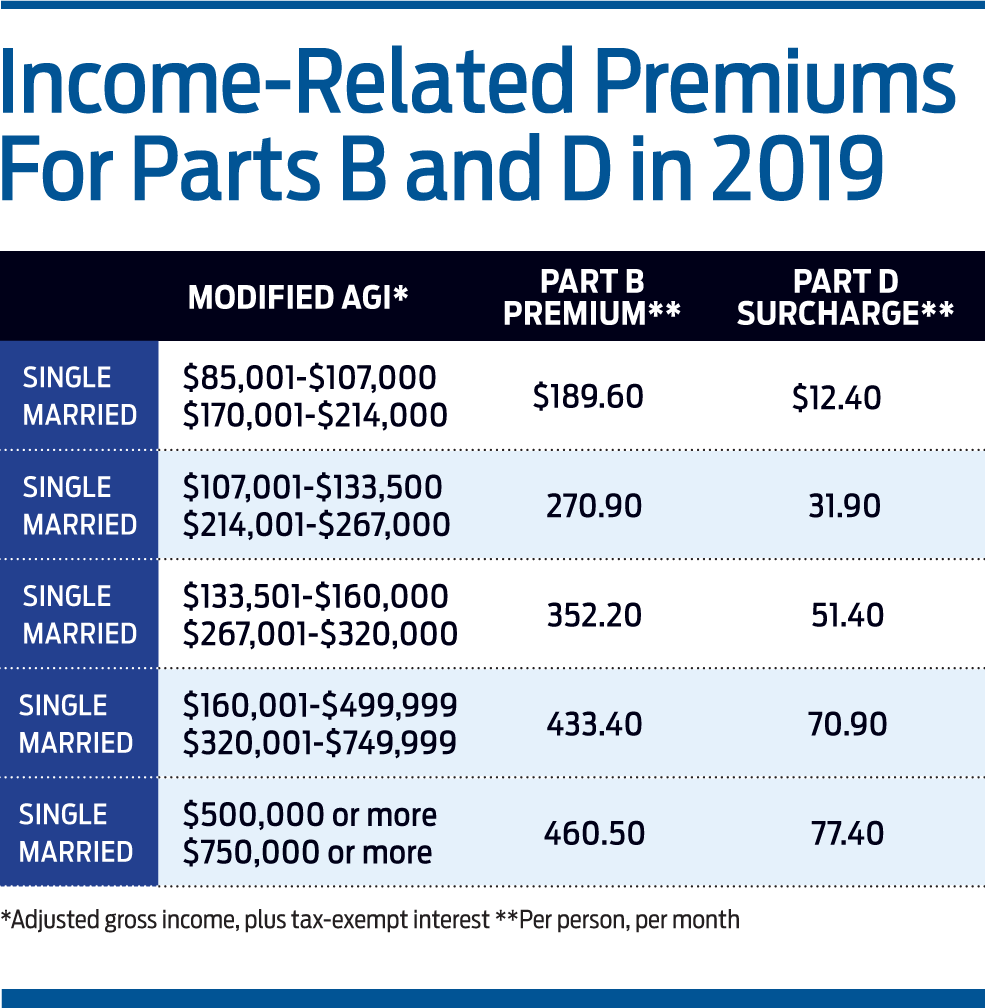Medicare Premiums to Rise Slightly in 2019
A possible workaround: See if you qualify for a Medicare surcharge waiver.

If you're enrolled in Medicare, expect to pay a bit more next year. Many beneficiaries will see some increase in their monthly Medicare Part B premiums. High-income retirees will also see a slight hike in income-related surcharges, with the biggest spike for those in the new top tier in effect in 2019.
The monthly standard Part B premium rises to $135.50 in 2019, up 1% from 2018. New Medicare enrollees, those who don’t get Social Security and those who are directly billed for Part B premiums are automatically subject to the standard premium. Part B covers doctor visits and outpatient hospital services.
Most beneficiaries receiving Social Security won’t be protected by the “hold harmless” provision in 2019. That provision keeps beneficiaries’ Part B premium increase from exceeding the increase in their Social Security benefits if premiums are automatically deducted from benefits. With a 2.8% cost-of-living adjustment for Social Security and slight hikes to Medicare premiums for 2019, only about 2 million beneficiaries, or about 3.5%, will pay less than the standard monthly premium because of the hold-harmless provision.

Sign up for Kiplinger’s Free E-Newsletters
Profit and prosper with the best of expert advice on investing, taxes, retirement, personal finance and more - straight to your e-mail.
Profit and prosper with the best of expert advice - straight to your e-mail.
Another 5% of beneficiaries will pay more: High-income beneficiaries pay a monthly income-related adjustment on top of the standard Part B premium, as well as a surcharge on their Part D prescription-drug plan premiums. See the box below for 2019 details.
Surcharges start to kick in for single filers with more than $85,000 in modified adjusted gross income—that is, AGI plus tax-exempt interest—and married couples filing jointly with more than $170,000 in MAGI. In the bottom four tiers, the surcharge increases about 1%, or a few dollars a month in 2019. For instance, the first surcharge tier climbs $2.10 a month, to a total monthly premium of $189.60. For joint filers, the premium surcharges are applied to each spouse on Medicare.
Those who land in the new top tier face the biggest premium spike. You vault into the top, fifth tier if you have MAGI of $500,000 or more for single filers or $750,000 or more for joint filers. Beneficiaries in that new top tier will pay $460.50 a month for Part B in 2019—a 7% jump from what they would have paid at the same income level in 2018.
A bit of good news for high-income beneficiaries: Part D premium surcharges fall about 5% in 2019 for those in the bottom four tiers. In the first tier, for instance, the Part D surcharge drops to $12.40 a month, compared with $13 in 2018. But again, if you fall into the new top tier, you’ll pay about 3% more than in 2018.
Qualifying for a Surcharge Waiver
Medicare premium surcharges are based on information from your tax return two years prior—so there’s little wiggle room now to escape a 2019 surcharge.
But not all hope is lost. See if you qualify for relief because of a life-changing event such as death of a spouse or retirement. Such events can make you eligible to use your current, lower income and avoid the surcharge. Learn more at socialsecurity.gov.
If you experienced one of those events since your 2017 tax return was filed, file Form SSA-44 with the Social Security Administration and provide the appropriate documentation, such as a letter from your former employer noting your retirement.
If you are in 2019 surcharge territory because of a windfall—say, a large profit from selling appreciated stock or a house—you are out of luck, at least for one year. One-time spikes in income don’t qualify for a waiver. But the pain should be brief. Medicare premiums are determined annually, and the surcharge will drop off in 2020 if your 2018 income falls below the surcharge income thresholds.

Get Kiplinger Today newsletter — free
Profit and prosper with the best of Kiplinger's advice on investing, taxes, retirement, personal finance and much more. Delivered daily. Enter your email in the box and click Sign Me Up.

-
 Six Ways to Pay Off High-Interest Debt (and Still Save for the Future)
Six Ways to Pay Off High-Interest Debt (and Still Save for the Future)Get out of debt and reach your goals sooner by starting with a well-thought-out plan.
By Kiplinger Advisor Collective
-
 Vaccines Medicare Covers for Free
Vaccines Medicare Covers for FreeThe U.S. is experiencing an outbreak of measles and is on track to have the most whooping cough cases since 1948; these vaccines Medicare covers for free can keep you safe.
By Donna LeValley
-
 457 Plan Contribution Limits for 2025
457 Plan Contribution Limits for 2025Retirement plans There are higher 457 plan contribution limits for state and local government workers in 2025. That's good news for state and local government employees.
By Kathryn Pomroy
-
 Medicare Basics: 11 Things You Need to Know
Medicare Basics: 11 Things You Need to KnowMedicare There's Medicare Part A, Part B, Part D, Medigap plans, Medicare Advantage plans and so on. We sort out the confusion about signing up for Medicare — and much more.
By Catherine Siskos
-
 The Seven Worst Assets to Leave Your Kids or Grandkids
The Seven Worst Assets to Leave Your Kids or Grandkidsinheritance Leaving these assets to your loved ones may be more trouble than it’s worth. Here's how to avoid adding to their grief after you're gone.
By David Rodeck
-
 SEP IRA Contribution Limits for 2025
SEP IRA Contribution Limits for 2025SEP IRA A good option for small business owners, SEP IRAs allow individual annual contributions of as much as $70,000 in 2025, up from $69,000 in 2024.
By Jackie Stewart
-
 Roth IRA Contribution Limits for 2025
Roth IRA Contribution Limits for 2025Roth IRAs Roth IRA contribution limits have gone up. Here's what you need to know.
By Jackie Stewart
-
 SIMPLE IRA Contribution Limits for 2025
SIMPLE IRA Contribution Limits for 2025simple IRA The SIMPLE IRA contribution limit increased by $500 for 2025. Workers at small businesses can contribute up to $16,500 or $20,000 if 50 or over and $21,750 if 60-63.
By Jackie Stewart
-
 457 Contribution Limits for 2024
457 Contribution Limits for 2024retirement plans State and local government workers can contribute more to their 457 plans in 2024 than in 2023.
By Jackie Stewart
-
 Roth 401(k) Contribution Limits for 2025
Roth 401(k) Contribution Limits for 2025retirement plans The Roth 401(k) contribution limit for 2025 increased, and workers who are 50 and older can save even more.
By Jackie Stewart